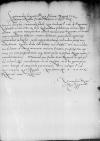Reverendis in Christo Patribus, dominis ⌊Ioanni Warmiensi⌋ et ⌊Tidemmanno Culmensi⌋ episcopis, sincere nobis dilectis
⌊Sigismundus⌋ Dei gratia rex ⌊Poloniae⌋, magnus dux ⌊Lithuaniae⌋, ⌊Russiae⌋, ⌊Prussiae⌋, ⌊Masoviae⌋ etc. dominus et heres
Reverendi in Christo Patres, sincere nobis dilecti.
Quae ⌊⌋[1] Paternitates Vestrae de ⌊Hyeronimo Zelislawski⌋, ea iam antea ex litteris ⌊Gedanensium subditorum nostrorum⌋ cognoveramus. Quorum iustis precibus adducti mandavimus Hyeronimo, ut se coram certis consiliariis sisteret causam dicturus, quamobrem inimicitias Gedanensibus indixerit neque eas persecuturus, sed iudicio potius rem transacturus. Quod si diem sibi dictum non obiisset, tum vero mandata una dedimus ad omnes ⌊terrarum nostrarum Prussiae⌋ praefectos sive capitaneos, ut eum prehenderent neque secus quam in hostem ⌊regni nostri⌋ animadverterent.
⌊⌋, quae factae sunt reverendissimo in Christo patri ⌊Culmensi episcopo⌋, mandavimus, ut ei satisfiat neve hoc genus quaerimoniae deinceps ad aures nostras perveniant.
Bene valeant Paternitates Vestrae.
Datae
⌊Cracoviae⌋, XX-a Augusti anno Domini M-oD-oXXXIX, regni nostri anno XXXIII.
Ad mandatum regiae maiestatis proprium
[1 ] cf. also ⌊⌋, ⌊⌋

